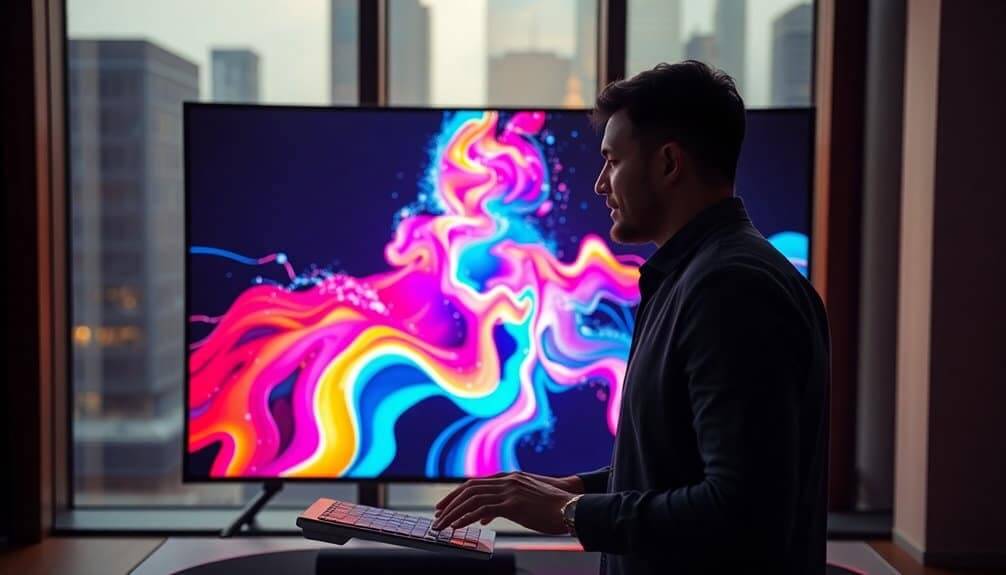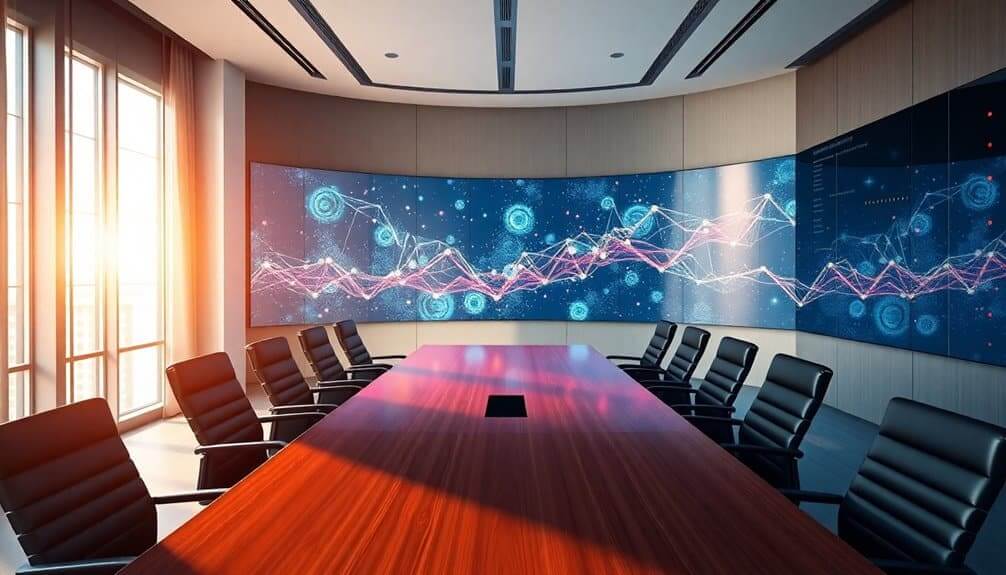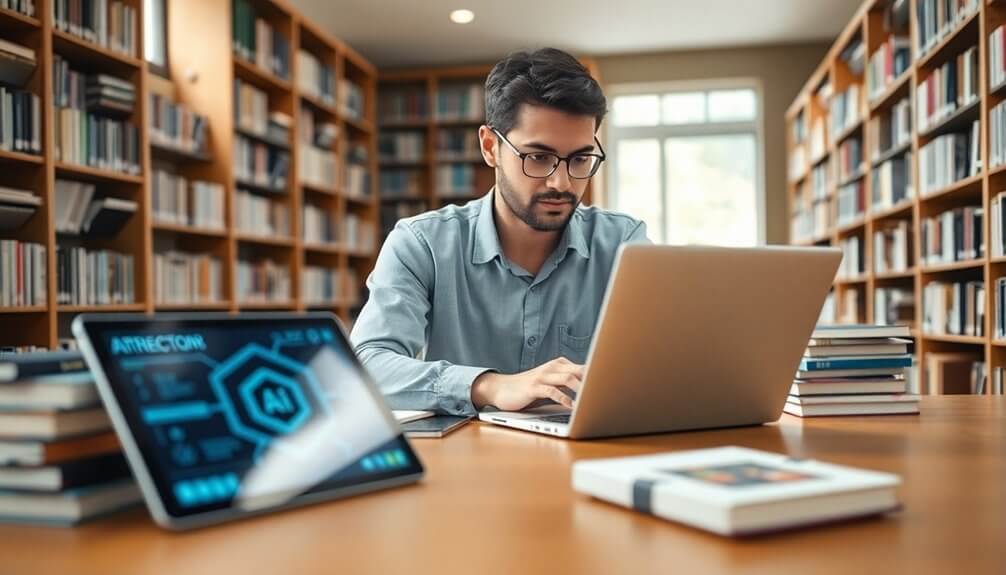You're witnessing a seismic shift in the art world, driven by the rapid advancement of artificial intelligence. As AI-generated art gains mainstream acceptance, the traditional boundaries between human and machine creativity are blurring. You might wonder, what role will human artists play in this evolving landscape? The AI art market is projected to soar to $40.4 billion by 2033, fueled by innovative tools and collaborations that redefine artistic expression. The intersection of human ingenuity and AI's precision is creating new aesthetic frontiers, but it also raises questions about authenticity and the future of art itself.
Key Takeaways
- AI is transforming the art world by generating new styles, forms, and techniques, pushing the boundaries of human creativity.
- The AI art market is projected to grow from $3.2 billion in 2024 to $40.4 billion by 2033, at a CAGR of 28.9%.
- Artists can leverage AI algorithms and tools to explore new creative avenues, generate unique visual styles, and experiment with unconventional techniques.
- AI art challenges traditional notions of creativity and authorship, leading to debates over machine creativity and the role of human artists.
- AI is redefining the art industry, from creation to curation and conservation, offering new opportunities for innovation and collaboration.
AI Art Market Expansion
The AI art market is witnessing a remarkable expansion, with its value skyrocketing from approximately $3.2 billion in 2024 to a projected $40.4 billion by 2033.
You're part of a rapidly evolving industry where AI is driving unprecedented growth, expected to soar at a Compound Annual Growth Rate (CAGR) of 28.9% from 2024 to 2033.
The pace of this expansion is even more pronounced when considering the AI art market specifically, which is projected to grow at an accelerated CAGR of 36.8% during the same period.
This market growth spells significant industry disruption, with AI reshaping how artworks are created, valued, and appreciated.
North America leads the AI in art market, accounting for over 40% of the revenue and reaching approximately $1.2 billion in 2024.
The cloud-based deployment model dominates, holding a 65% share, and machine learning captures more than 40% of the AI in art market.
AI-generated art is becoming more integrated, expected to represent 5% of the total contemporary art market by 2025.
The AI in Art Market's growth is also driven by the increasing adoption of AI tools by digital artists, which currently stands at 29% of digital artists.
As AI art gains a foothold in mainstream art markets, it's clear that this transformative movement is redefining the boundaries of creativity and art. AI art tools use machine learning algorithms and neural networks to generate new, original art pieces by analyzing and learning from large datasets of artworks.
The future of AI in art holds immense possibilities, promising new aesthetic horizons and opportunities for innovation in the creative industry.
Creative Collaboration Tools
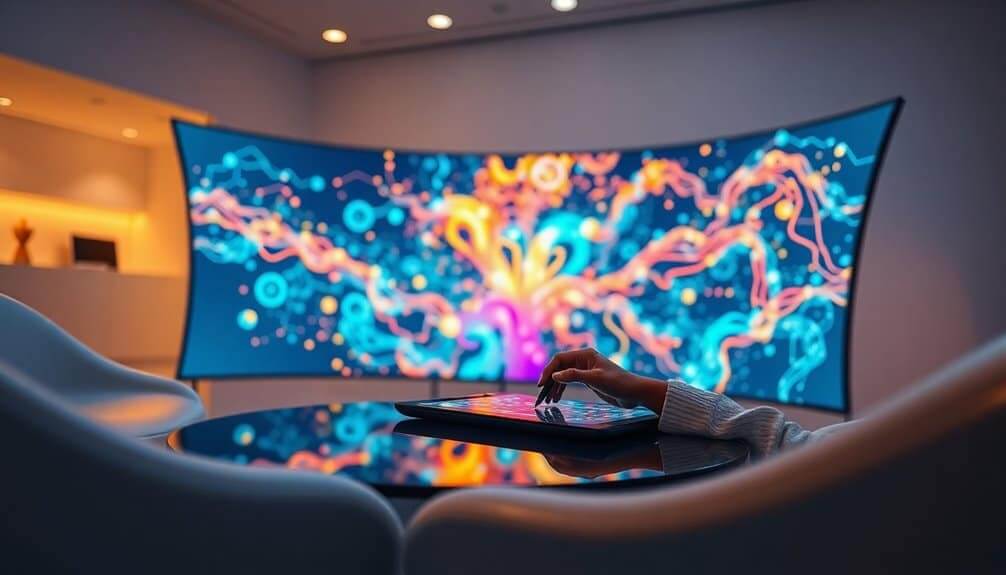
As AI reshapes the creative landscape, it's propelling a new wave of co-creation, where human artists collaborate with AI tools to uncover novel artistic expressions.
This fusion of human creativity and machine capabilities is revolutionizing the art world, offering unparalleled creative freedom and enhancing artistic intuition.
AI-driven co-creation tools are at the forefront of this movement.
- Generative AI tools: Rapidly prototype ideas and explore new visual styles with platforms like Adobe Firefly.
- AI-powered painting assistants: Enhance your artistic process with AI suggestions for colors, textures, and styles.
- AI-driven music composition: Generate melodies, harmonies, and entire tracks with AI tools.
- AI-assisted video creation: Integrate AI into video platforms for efficient editing, special effects, and script generation.
- AI art recommendation systems: Personalize artistic experiences with AI-recommended artworks based on your preferences.
These tools empower artists to break through creative barriers and explore uncharted territories in their chosen mediums. However, it's essential to understand that AI's capabilities in art are fundamentally grounded in human-generated data.
By harnessing AI's capabilities, you can tap into a new level of artistic expression and collaboration, bridging the gap between human creativity and machine intelligence.
AI has become a crucial creative assistant in many artistic endeavors, enabling artists to focus more on high-level creative decisions. AI tools such as neural networks, machine learning, and algorithms have enabled AI to perform complex intellectual activities without human interaction, further expanding its role in artistic collaboration.
This synergy is transforming the art world, offering unprecedented opportunities for creative freedom and innovation.
Artistic Authenticity Concerns
Because AI-generated art increasingly mimics traditional art forms, concerns about artistic authenticity are rising, forcing us to question whether these creations are original or merely derivative products of their programming and data.
You've probably noticed that AI-generated images are becoming more sophisticated and indistinguishable from photographs or traditional art, making it harder to differentiate what's been created by hand versus generated by AI. This raises significant questions about the authenticity of art and the true nature of creative expression.
You need to be aware that AI algorithms can perpetuate biases and stereotypes if not carefully designed and trained, influencing the authenticity of AI-generated art.
The over-reliance on training data also raises concerns about the lack of human creativity and genuine emotional depth in these creations. When AI art generators produce images without proper attribution, it can be seen as a breach of artistic integrity, akin to plagiarism. Moreover, some art historians estimate that as much as 20 percent of artworks in museums' collections might be reattributed to different artists or even to skilled fraudsters, highlighting the critical importance of authenticity and validation protocols.
Ensuring authentic expression and respecting creative authorship are vital in addressing these artistic authenticity concerns. Transparency and attribution are essential to distinguish AI-generated art from human-created works, protecting the value and definition of art.
Art educators must recognize the importance of balancing AI-generated imagery with traditional art methodologies Balancing AI Use to foster innovation while preserving artistic integrity.
AI-generated art is fundamentally created through a process that combines algorithms and data, which can both enhance and limit the creative possibilities it can explore.
New Aesthetic Frontiers
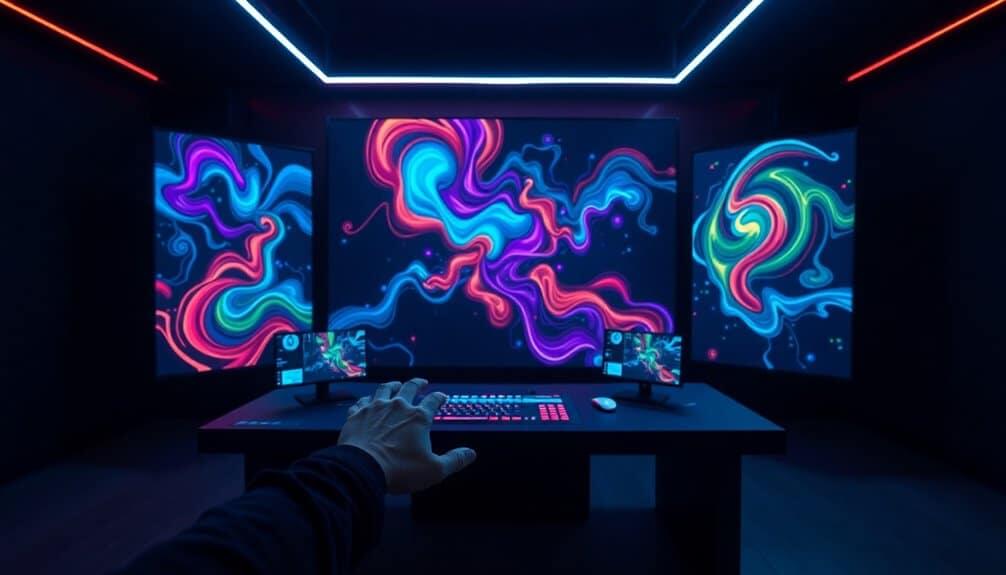
AI-generated art now offers hyper-realistic images, artworks indistinguishable from photographs, and style fusion techniques that blend multiple artistic styles into a single piece.
The integration of AI into artistic processes enables new creative possibilities and reshapes traditional practices by fostering collaborative partnerships. AI-generated art also challenges traditional notions of creativity and authorship, leading to debates over machine creativity.
Art has witnessed profound transformations throughout history, reflecting cultural, technological, and intellectual progress.
AI Art Innovation
AI Art Innovation (New Aesthetic Frontiers)
Delving into the domain of AI-generated art, innovative interfaces enable artists to interact with their creations in unprecedented ways.
This dynamic is part of a larger movement often referred to as the Digital Renaissance, where artistic freedom isn't just about expression, but also about embracing technology to expand those expressions.
Some key features of AI Art Innovation include:
- AI-driven artistic exploration: AI introduces innovative interfaces that allow for deeper interaction between artists and their creations.
- Dynamic art forms: AI can analyze and respond to environmental factors or audience interactions in real-time, providing unique experiences.
- Machine learning integration: AI algorithms learn from historical styles, patterns, and techniques to generate artwork that's both innovative and reminiscent of human creativity.
- Interactive installations: AI-powered installations create a dynamic relationship between the artwork and its audience, ensuring no two experiences are alike.
- Expanding artistic horizons: AI extends the artist's palette with limitless possibilities, from generating intricate digital paintings to sculpting forms using 3D models. The concept of a collective unconscious has influenced AI-generated art, blurring the lines between human and machine creativity.
This fusion of AI and art is redefining the boundaries of what art can be and how it's created, offering new avenues for artistic experimentation and innovation. AI democratizes art creation, making it possible for anyone to create art, regardless of skill level or experience.
Artists like Refik Anadol showcase how generative AI technology can be used to visualize data and the physical world in new and captivating ways.
This fusion is offering new avenues for artistic experimentation and innovation.
Generative Art Techniques
AI continues to reshape the art world, Generative Art Techniques are emerging as a pivotal force in pushing the boundaries of artistic expression.
By leveraging machine learning algorithms like Generative Adversarial Networks (GANs) and Variational Autoencoders (VAEs), artists can now create diverse and novel artworks that challenge traditional notions of creativity.
These techniques enable artists to input parameters and guide the process while AI contributes unique insights, fostering a creative synergy that transforms the artistic process.
The digital fusion of human and AI creativity yields novel artistic expressions, making art more accessible to a wider audience.
Traditional notions of authorship and originality are challenged, as AI-generated art involves collaboration between humans and machines.
With AI, you can explore new creative possibilities, generating artworks with internal parameters and bypassing traditional human intervention.
This technology empowers human creativity, opening up novel avenues for expression and pushing the frontiers of what's possible in art and design.
Art prompts serve as catalysts for creativity by providing inspiration and a starting point for artistic work, such as using the example of specifying artistic mediums and styles.
AI art also raises complex questions about intellectual property rights, highlighting the need for clearer guidelines on ownership and usage-rights.
The blend of AI and human creativity is further enhanced by AI's ability to simplify repetitive tasks, providing artists with more time to focus on the core creative process.
New Creative Horizons**
The burgeoning landscape of art is witnessing a seismic shift with the advent of new creative horizons, powered by the innovative fusion of artificial intelligence and traditional art techniques.
This convergence reveals unprecedented levels of artistic freedom, allowing creators to push boundaries and explore novel forms of expression.
Key highlights of this transformation include:
- AI-Driven Inspiration: AI algorithms can suggest modifications to artworks and even conceive themes and motifs, acting as a virtual muse.
- Dynamic Artworks: AI-generated visuals can respond to environmental factors or audience interactions in real-time, creating immersive experiences.
- Enhanced Creativity: AI accelerates the creative process, enabling artists to experiment with more ideas and work more efficiently.
- Democratization of Art: AI-powered tools enable non-artists to create complex pieces, making art creation more accessible.
- Personalized Art Experiences: AI can personalize art experiences by adapting to the viewer's mood, preferences, or physical presence.
This collaboration between humans and machines is redefining the art world, offering artists new avenues for expression and viewers new ways to engage with art.
The virtual muse provided by AI is opening doors to new aesthetic frontiers, where artistic freedom is limitless.
Changing Art Market Dynamics
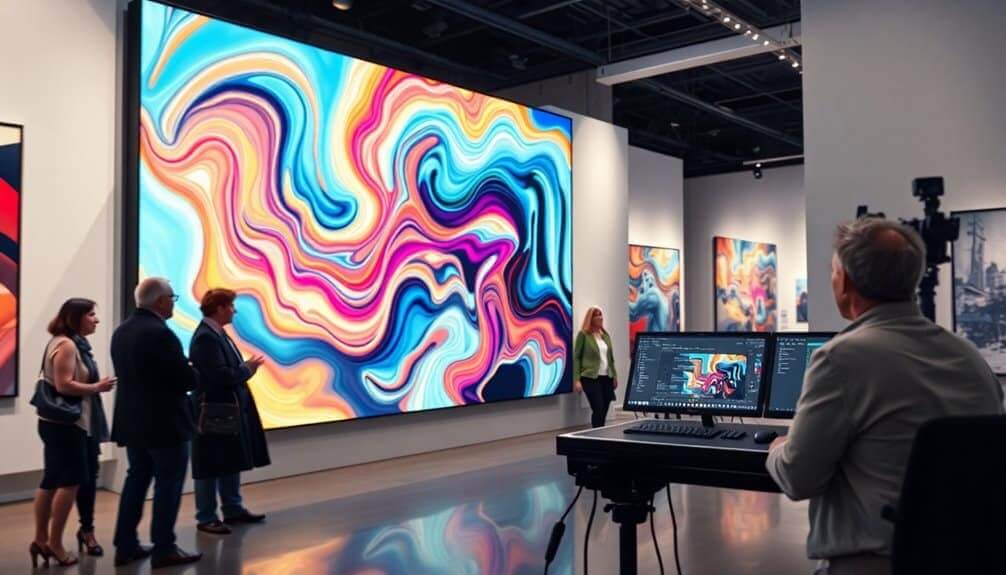
You're witnessing a significant shift in the art market, driven by the integration of artificial intelligence into creative processes. AI tools aren't only changing how artworks are created but also transforming how art is valued and appreciated. The global AI in art market is expected to reach USD 40.4 billion by 2033, with a CAGR of 28.9% during the forecast period from 2024 to 2033. Some galleries, such as Tina Kim Gallery, have already incorporated AI into their operations, using it as a research tool to assist with tasks like text translation. The AI in art market was valued at USD 3.19 billion in 2023, reflecting rapid growth in this emerging sector.
Art Market Adaptation
Evolution is reshaping the art market landscape, driven by the integration of artificial intelligence.
This digital revolution is transforming how art is created, bought, and appreciated.
As AI becomes more entrenched in the art world, it's changing the dynamics of the market, impacting everything from the way art is produced to how it's valued.
- Market Growth: The AI in Art Market is expected to grow from USD 3.2 billion in 2023 to USD 40.4 billion by 2033, at a CAGR of 28.9%.
- AI Adoption: 75% of artistic organizations use AI for personalized recommendations, and 78% of artists believe AI will bring new aesthetic possibilities[Query].
- NFTs and Digital Art: The increase in digital art and NFTs presents significant opportunities for the AI in Art Market.
- Art Conservation: AI helps in art preservation by predicting decay with 86% accuracy and aiding in the maintenance of artworks[Query].
- Artistic Collaboration: AI facilitates collaborations between artists and machines, creating a deeper dialogue between human and machine intelligence[Query].
This transformation isn't just about market size but about how AI is redefining the art industry, from creation to curation and conservation. AI-generated art is projected to represent 5% of the total contemporary art market by 2025 AI Market Share.
Artists are facing significant challenges due to the unauthorized use of their work to train AI systems, highlighting the need for proper compensation and consent structuresCompensation for Artists.
AI-Driven Creative Shift
AI-Driven Creative Shift (Changing Art Market Dynamics)
Over the past decade, a seismic shift has been unfolding in the art market, driven by the rapid integration of artificial intelligence. This AI-driven creative shift is changing art market dynamics, expanding the possibilities for artists and collectors alike. AI-generated art is now a significant force, pushing the boundaries of creativity and challenging conventional notions of authorship and artistic expression.
The market is expected to see significant growth, with the Generative AI in Art Market projected to reach USD 8,628.5 Million by 2033, growing at a CAGR of 40%. AI tools allow artists to explore new styles and techniques, offering unprecedented creative freedom and efficiency. The use of AI in art restoration has also become more prominent, enabling the accurate prediction of original appearances and suggesting precise restoration methods, preserving cultural heritage through AI-assisted art restoration.
Key Trends and Facts:
| Trend/Impact | Description |
|---|---|
| Expansion Beyond Visual Art | AI-generated art is now branching out to music, literature, leveraging machine learning algorithms and neural networks. |
| Market Growth | The Generative AI in Art Market is expected to reach USD 8628.5 Million By 2033, with a CAGR of 40%. |
| Technological Advancements | Advances in deep learning and neural networks enhance generative AI capabilities, enabling realistic images and diverse artistic styles. |
| Artistic Freedom | AI tools allow artists to explore new styles and techniques, offering unprecedented creative freedom and efficiency. |
| Human Touch | AI-generated art often requires human collaboration, ensuring that the human touch remains integral to artistic creation.
Transforming Art Valuation**
AI-generated art is redefining the dynamics of art valuation, leveraging machine learning models to analyze vast datasets and identify patterns and trends.
This disruption in the art market is transforming how artworks are priced, sold, and managed. Companies like Artory and Appraisal Bureau are at the forefront, using AI to improve the precision of art appraisals by tracking an artwork's history and predicting future market trends.
Key aspects of AI in art valuation include:
- AI-driven pricing strategies that provide dynamic and accurate valuations based on historical sales data and market trends.
- Detection of artwork forgery, enhancing the integrity of the art market.
- Marketing and audience targeting, connecting potential buyers with artworks that match their preferences.
- Tracking emerging artists and trends, aiding curators in making informed decisions.
- Increased transparency and liquidity in the art market through data-driven appraisals.
With AI's ability to analyze large datasets, it excels in valuing mid-tier artworks, offering a cleaner view of their value. Human appraisers can then refine these predictions for high-value pieces, creating a collaborative approach that revolutionizes art valuation. The use of AI in art auctions dates back to significant advancements in 2018 when a technological start-up, Thread Genius, was integrated into Sotheby's digital strategy, utilizing visual recognition algorithms to select artworks suitable for potential buyers.
The AI in Art Market is expected to grow significantly, projecting a CAGR of 28.9% over the forecast period from 2024 to 2033. This art market disruption, driven by AI's pricing strategy, is making the industry more accessible and diverse. The integration of AI further assists in mitigating the unpredictability of art prices by providing a systematic approach to valuation, thus addressing the issue of prices that seem to defy human logic.
The Role of Human Artists
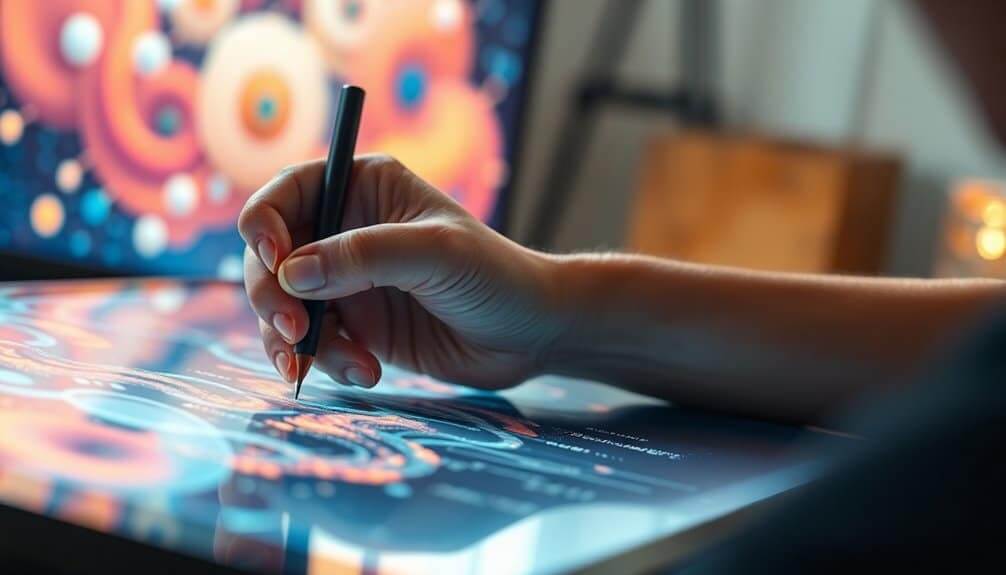
In the domain of AI art, human artists play a pivotal role, shaping the creative process by providing initial concepts, guidance, and input that AI algorithms then build upon.
Your involvement is vital for determining copyright protection, as only works with a human author are eligible. However, the distinction between human and AI contributions can be blurred, making it challenging to ascertain the level of creative control you exert as a human artist.
To effectively collaborate with AI, you need to develop skills in using AI platforms and tools to their fullest potential.
This includes mastering the art of crafting nuanced instructions and prompts to influence the AI's creative output. By traversing this complex interplay of technical acumen, artistic vision, and ethical considerations, you can harness AI to enhance your creative process and explore uncharted territories. AI's ability to analyze vast amounts of data to generate unique concepts is a crucial factor in this process.
This collaboration underscores the difficult interplay between technological innovation and artistic expression, particularly with regard to artistic identity and collaborative dynamics.
The U.S. Copyright Office emphasizes the need for artists to introduce sufficient creativity and human input, as AI-generated content itself is not eligible for copyright protection.
AI Art Innovation Trends
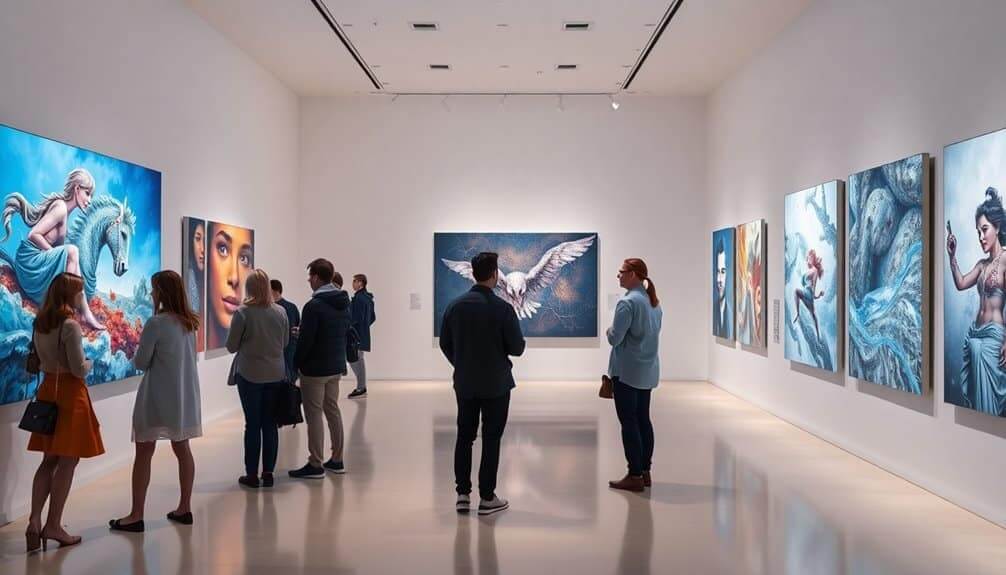
- Hyper-Realistic Artwork: AI tools like DALL-E and NVIDIA GauGAN are creating images so realistic they're often indistinguishable from photographs or traditional art.
- Style Fusion: AI merges multiple artistic styles into a single piece, creating unique artworks that blend different art movements.
- Interactive Art: AI-driven installations are becoming more interactive, responding to viewer movements or inputs.
- Personalization and Customization: AI generates personalized art, adapting content and style to individual preferences.
- Text-to-Image Generation: Advances in AI enable detailed images from textual descriptions, opening new avenues for artistic expression.
These trends aren't only transforming the way art is created but also how it's perceived and consumed, offering a new era of collaboration between human creativity and artificial intelligence.
AI's impact on the art world is profound, reshaping traditional norms and opening up new possibilities for artistic innovation.
Future Art World Impacts**
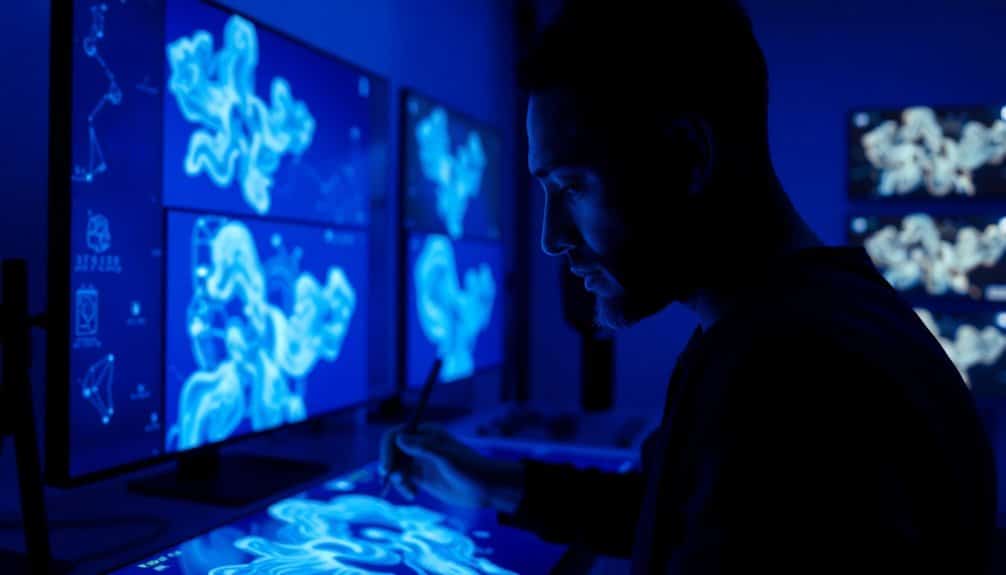
As the art world continues to evolve, the integration of artificial intelligence (AI) promises to have a profound impact on its future.
You're about to witness significant changes that will reshape artistic expression and alter the cultural landscape. The AI in Art Market is projected to reach USD 40.4 billion by 2033, growing from USD 3.2 billion in 2023 at a CAGR of 28.9%.
This rapid expansion indicates that AI will become an indispensable tool for artists, enabling them to create new forms of art and pushing the boundaries of creativity.
With AI-generated artworks gaining traction, you'll see a blurring of lines between traditional and digital domains.
The fusion of AI and human creativity will democratize creation, offering tools that amplify human imagination and open up paths to new ideas and insights.
New art forms will emerge, including AI-driven interactive installations, dynamic digital sculptures, and AI-human collaborative performances.
As AI becomes more integral to art, societal and ethical considerations will also come to the forefront, challenging traditional notions of authenticity and the value of art, leading to a cultural shift that will redefine the art world.
Frequently Asked Questions
How Does Ai-Generated Art Differ From Human-Created Art?
Like the tale of Pygmalion, where a sculptor's creation was infused with life, AI-generated art breathes through algorithms and data, while human art beats with the heart of personal experiences and emotions.
As you explore the differences, you find AI art relies on machine learning, lacking the artistic intent and emotional depth that human art embodies through a creative process driven by individual thoughts and feelings.
AI's precision contrasts with human art's subjective nuances.
Can AI Art Be Considered Authentic or Original?
You're likely to question whether AI art can be considered authentic or original.
While AI can ignite your creative spark and produce visually striking pieces, its dependence on training data raises concerns about its artistic license.
Fundamentally, AI art is a product of algorithms and data, lacking the human experience and emotional depth that underpin traditional art.
This limitation makes it challenging to view AI art as entirely original or authentic.
What Are the Ethical Implications of AI Art on Traditional Artists?
You might think AI art doesn't affect traditional artists, but it does.
The rise of AI-generated art threatens their livelihoods and undermines the value of human creativity.
Ethical concerns include lack of artistic ownership and creative agency, as AI models use copyrighted works without permission.
This not only infringes on artists' rights but also impacts their ability to control and profit from their original works.
How Can Artists Ensure Their Ai-Generated Art Is Unique and Valuable?
To guarantee your AI-generated art is unique and valuable, you need to focus on a few key strategies.
Leverage diverse training data to create a digital fingerprint that sets your art apart[2,4].
Embrace style evolution by regularly updating and expanding your datasets to prevent repetition.
Collaborate with human artists and incorporate feedback loops to inject unique perspectives and refine AI outputs[1,3].
Will Ai-Generated Art Replace Human Artists in the Future?
You're living in a digital age where artistic evolution is unfolding right before your eyes.
AI-generated art is becoming increasingly sophisticated, sparking concerns about human artists' roles.
However, the rise of AI art isn't a replacement, but a collaboration.
Digital democracy is empowering artists to team up with AI, leveraging its technical prowess to boost efficiency and creativity.
Human touch still reigns supreme, ensuring AI won't fully displace human artists.
Conclusion
You're about to witness a creative explosion like no other. AI is turbocharging the art world, transforming it into a $40.4 billion behemoth by 2033. With AI-driven tools, artists are pushing boundaries, collaborating in unprecedented ways, and redefining traditional notions of artistry. The lines between human and machine creativity are blurring at lightning speed, propelling the art world into uncharted territories of innovation and growth. Buckle up, because AI is revolutionizing art as it stands.

